|

HO Scale Locomotive Module with Sound
The LM-3S is a module that you can install into a model train locomotive so the
locomotive can be controlled and setup by a Ring Engineering RailPro Controller,
such as the HC-2 Handheld Controller with a Color Touch Screen! After the LM-3S
is installed in a locomotive, you will be able to control the locomotive speed,
direction, up to 6 light outputs and sounds! The LM-3S has “Direct Radio” (RF
transceiver) built inside. The built in RF module allows commands and data to be
sent and received to and from the module. You can load a picture of your choice
into the LM-3S module. Then you will be able to touch the screen of the HC-2 to take control of
your locomotive! You can even download new sounds and light effects using the
built in Direct Radio!
The LM-3S is electrically compatible with the DCC plug found in many locomotives
to promote easy installation.
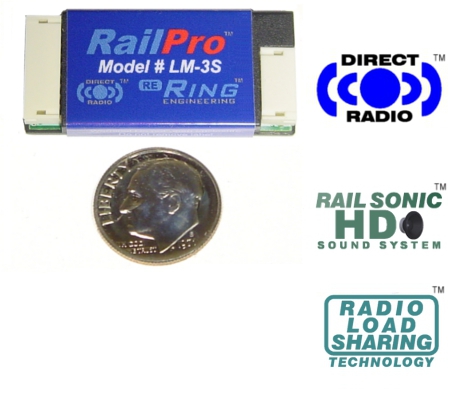 |
| The LM-3S is
equipped with Direct Radio! This allows Ring Engineering Controlling Devices
such as the HC-2, Handheld Controller with Color Touch screen, to control
and configure your locomotive by sending and receiving data directly to the
LM-3S through the air by use of RF transmission! The Direct Radio is very
fast giving your locomotive quick response to your controls. Further, a
controlling device can detect your LM-3S with just a few touches on the
screen. Because of Direct Radio, you can load a picture of your locomotive
to the LM-3S! You can also load Sounds, Light Effects and much more!
Your LM-3S is equipped with
Rail Sonic HD Sound System! This is Ring Engineering's proprietary technology
that allows your LM-3S to produce realistic locomotive sounds!
Radio Load Sharing is a
truly an innovative invention from Ring Engineering. It allows
your locomotives that are linked together
(sometimes called Consisted
or MU'ed)
to actually share pulling power. Only RailPro equipped
locomotives use Direct Radio to talk to each other to be sure each
locomotive pulls its share of the load! Even more amazingly, Ring
Engineering's patent pending process only takes seconds to setup!
Six
light outputs. Can be configured for multiple light effects on a
single output including On/Off, Dim, Ditch, Mars, Strobe, and more!
Additional light effects can be loaded using DirectRadio!
Built in protection with fault reporting by Direct Radio!
Tiny size 1.50 x 0.68 x 0.25 Inches for easy fit.
|
|

Stock Status:
Ships 1 to 3 Business Days
Price $119.99

You will need a RailPro controller such as a HC-2 (Handheld
Controller with Color Touch Screen - Not Included) to control, setup and monitor
a LM-3S. Actual HC-2 screen shots are shown below!
Pages to Select and Control Locomotives
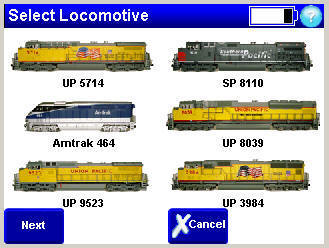
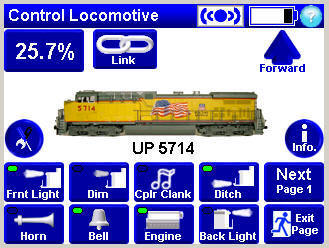
Pages to Setup Locomotives
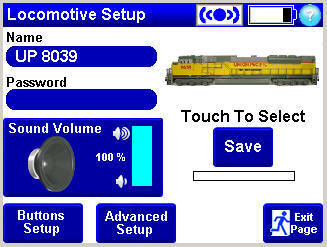
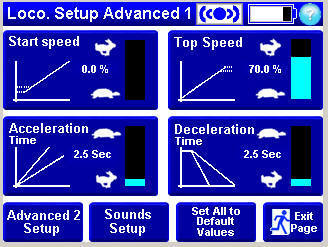
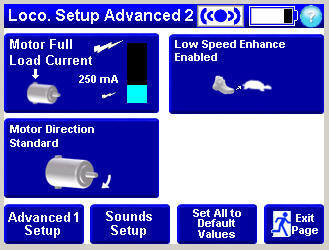
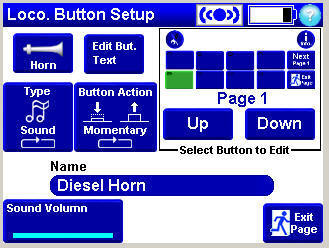
Page to Monitor Locomotive
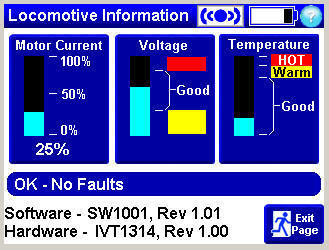
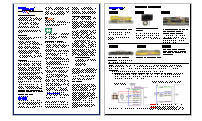
Instruction Sheet
Package Contents:
LM-3S Locomotive Module
WH-6 6 Pin Wiring Harness
Instruction Sheet
US Patent 8,807,487 and 10,780,362
Made In USA
Not recommended for persons under the age of 14
LM-3S Frequently Asked Questions
If I
link different types of locomotives will they run well together?
(This is often referred to as Consisting or MU'ed)
YES.
In fact you will only need to set one
adjustment to get locomotives with even different motors and gear
ratios to work very well together. The one adjustment that needs to
be set has an auto set feature. You can actually setup
different locomotives to run well together in under a minute.
All you need to do is run the auto set feature for the Motor Full
Load Current adjustment on each locomotive.
The way RailPro links locomotives
together is patented technology and unlike any DCC system. Direct
Radio allows RailPro locomotives to communicate together almost
instantly to be sure that each locomotive pulls its portion of the
load and runs smoothly together. Any DCC system that we are
aware of, only allows communication to locomotives and the locomotives
cannot talk to each other. Ring Engineering's Direct Radio allows all
RailPro products to communicate in both directions at full speed!
Two way, full speed communication is key to many of RailPro's easy
to use and unique features including the way linked locomotives run
together.
What locomotives
should I get to install RailPro
locomotive modules in?
It
is best to get DCC Ready locomotives (sometimes called DC
locomotives). You would want to ask if you can plug in a DCC
decoder to the locomotive. If you can, then you very likely
can plug in a RailPro module. Common DCC plugs in DCC ready
locomotives are 8, 9 and 21 pin. RailPro module has 9 pin so
if you get a DCC ready locomotive with a 9 pin plug then you can
just plug in the RailPro module. If you get a locomotive with
a 8 or 21 pin DCC plug you can get 8 to 9 pin DCC adapter wiring
harness or 21 to 9 pin DCC adapter wiring harness as necessary.
As of this time we do not sell Adapter wiring harness but some DCC
suppliers do.
You want to avoid DCC with sound locomotive. Often a
locomotive manufacturer will offer a locomotive as DCC ready (with a
DCC plug an no DCC with sound electronics) and a DCC with sound
locomotive. A DCC with sound locomotive often costs $100
more than the same DCC with sound locomotive that is DCC
ready. Since our module costs less than $100 you can have a
RailPro loco for about what a DCC with sound locomotive costs.
If you have a DCC with sound locomotive and you want to change it to
RailPro, you can remove any circuit boards leaving two wires for the
motor, each light, speaker and track pickup. Then you can wire
in one of our WH-9 (Wiring harnesses
with a DCC 9 pin plug on one side and bare wires on the other) so
you can plug in a RailPro module. If you remove a factory board and
the locomotive has LEDs or low voltage lights, then the factory
board likely had dropping resistors on it for the lights. So
if you wire in a WH-9 you will want to be sure to add the proper
dropping resistors per the LM instructions (on this page in PDF
format).
Can I convert old DC locomotives to
RailPro?
YES.
Almost
any locomotive can be converted to RailPro. Older DC only
locomotives (ones that have no DCC plug) can be converted to RailPro
by using the RailPro locomotive wiring diagram and wiring in
our WH-9
(Wiring harnesses with a DCC 9 pin plug on one side and bare wires
on the other)
to plug in a RailPro module. When converting DC locomotives to
RailPro you need to look out for motors or lights that are connected
to the frame. The motor and lights will need to isolated from the
frame because often the frame is connected to the track electrical
pickup (thought the wheels on one side) and if these connections are
not disconnected, the RailPro locomotive module could be damaged.
One possible problem you may run into with older locomotives is that
some of the very old locomotives may draw too much power for the
RailPro locomotive module. In that case the
RailPro locomotive module may turn off and report to the handheld controller an over temperature
fault. Some people use very old locomotives with the
RailPro locomotive module by replacing the
motor with a newer more efficient motor that needs less power. If you are
interested we can recommend shops that specialize in this type of
installation work.
Click here for more
information on converting older DC locomotives to RailPro.
Can RailPro
locomotive modules be battery powered?
YES.
There are customers that are running
RailPro locomotives that are battery powered now. However, we
do not believe that battery power is the best choice for the
majority of users. We believe that a wall powered layout is a better
solution. Click here for the
long answer.
Warning: High power batteries can explode, catch fire, release toxic
fumes etc. so you should be aware of all dangers and proper use
before using batteries.
If my club is DCC
can I
run RailPro on the club layout?
YES.
You can take your RailPro equipped
locomotives and Handheld controllers to a club that has a DCC layout
and run it on their layout. You can run your RailPro
locomotives on the same tracks and at the same time while other club
members are controlling their DCC locomotives. However, you
will only be able to select and control RailPro equipped locomotives
and you will not be able to control DCC locomotives. DCC cabs
can control your RailPro locomotive because RailPro
locomotive modules respond to DCC and Direct Radio commands from
RailPro controllers such as the HC-2 handheld controller.
If my locomotive has
a RailPro module installed can I run it with typical DCC systems?
YES.
A Locomotive with a RailPro module installed
is dual mode! You can control the locomotive with Radio
control and or DCC control!
How far does
the Direct Radio signal reach?
You can control locomotives on huge HO scale layouts
with outstanding control using Direct Radio. The Direct Radio signal can reach
over 100ft in an open environment. When properly setup, you can achieve fast
and dependable control that has the feel of being directly wired to your
locomotives.
If you want to control your trains from the far side
of your layout, we recommend a repeater every 15 ft for areas divided into small
rooms. Our power supply has Direct Radio built in and can be used as a
repeater. With one PWR-56 in the middle of the layout, you can expect
outstanding coverage for a 30 ft x 30 ft layout while transmitting through
multiple walls. If the room is open, it may work well for 50 ft x 50 ft or even
larger areas with only one repeater. The current program in the handheld
controller lets you use up to 4 repeaters for outstanding coverage on huge
layouts.
You can run RailPro without a repeater. For example
using only a handheld and locomotive equipped with a RailPro module. If you
follow your trains (staying within 15-20 feet) you will not need a repeater and
you can expect fast and dependable control. However, if transmitting through multiple walls,
you might find that at some angles you will loose communication at 40 feet
away. By adding repeaters as necessary, you can get fast and dependable control
from over 40 feet away through multiple walls.
Since RailPro is all wireless and can transmit over 100 feet, can
anyone control my train set?
No.
RailPro has a simple solution for stopping unintentional or unauthorized users from
controlling your equipment. You can set a password in each piece of
RailPro equipment. For example, when you set a password in a
locomotive module, then only the people that you share the password with will
be able to control your locomotive. This is a great feature in a club
or model train show environment because you can have complete control over
who can control or adjust your RailPro products.
Is the response time good?
YES.
The response time is so good that you feel like you are connected to the
locomotive. As soon as you change speed, the locomotive instantly
responds. The touchscreen is so fast that you feel that there is no
detectable delay from pressing the screen to seeing the action on a
locomotive such as the lights turning on or off. The exceptionally
smooth speed control knob gives you the feel of using an analog controller!
If I install a RailPro locomotive module in a locomotive that I
already own, what do I need to do so the handheld controller will display a
picture of my locomotive?
Since Ring Engineering
does not know what locomotive you are going to install a locomotive module
into, our locomotive modules are preloaded with a generic locomotive
picture. You can change the picture on your locomotive module to match your
locomotive. You can load pictures from Ring Engineering’s Internet
site or use our RailPro Assistant software to convert your own pictures to
RailPro format and load them to your handheld controller and locomotive
modules. If you find a picture of your locomotive on our Internet site, you can load it
to your locomotive module for no charge. If you cannot find a picture of your
locomotive, then you can take a picture of your locomotive with a digital
camera and email your locomotive picture to Ring Engineering or use our
RailPro assistant software to convert it to RailPro format. See
RailPro Assistant Program for
complete details.
Is it difficult to get files like pictures, sounds, and light
effects from Ring Engineering's Internet site?
NO.
Basically you use our RailPro Assistant
software to select from lists of pictures, sounds, light effects, and programs available
from Ring Engineering's Internet site to download. Connect your handheld
controller with a USB cable and press the download button on the handheld
controller. The
handheld controller
will copy whatever files you selected from Ring Engineering's Internet site
onto your handheld controller. To send a file to a locomotive, you select Copy File,
choose the picture of the locomotive you want the file to go to, and then choose
the file to copy. Then you go to the adjustments and setup the locomotive to
use the new file.
What about RF interference?
Our RailPro system uses
advanced technology like cell phones where many can be in use at the same time in
the same area. Our products are not like the easily disturbed RF products found
in many toys. This makes it unlikely that you will experience any
interference. Our products have worked successfully around wireless computer
networks cell phones etc. Any RF product may have, or cause, some type of
interference but because of the technology that we use it is very unlikely.
At the time of this writing we have really had no users
complain about not being able to dependable control their trains
with RailPro. .
Can the locomotive module fit
into all HO scale locomotives?
We believe that our locomotive modules are small
enough that they can be fit into almost any normal locomotive (typical switch
engines and larger). There are shops that do locomotive module installation
work. We would be happy to recommend a shop for you if you would prefer someone
else do the installation work.
Will
RailPro work in brass shell locomotives?
We have not done much testing with RailPro in metal
or brass locomotives but several of our customers have said that they work well
in brass and full metal locomotives. The Model RR News installed one in a full
die cast locomotive and told us that it worked well.
RailPro locomotive modules might not have as much range in metal body (brass) locomotives
because the RF signal may get attenuated. We have been told that the range
is typically about 2/3 of its normal range.
**
Using Battery Power
RailPro system uses fixed voltage DC
power. So, yes, it could be powered by a battery. The minimum voltage would be
about 12 volts.
Of course we only recommend using RailPro components provided by Ring
Engineering for safety and so you can be completely confident about the products
working together.
If you are considering using battery power because of dirty track issues or
because you think wiring is difficult, we think you may want to consider the
following:
1)
Because RailPro is a fixed voltage DC system we are confident that you will not
need to clean your RailPro track nearly as often as you clean a track powered by
DCC.***
2) Most locomotive do not have ample space for decoders and speakers let alone
any extra space for batteries and possibly a step up converter.
3) The cost involved for the high power batteries required would be expensive.
4) Your run time would limited to probably less than an hour even with new
efficient motors and unacceptably short with older low efficiency motors with
reasonable size batteries.
5) Typical number of recharges for today’s batteries is about 300-500 charges. A
HO locomotive could need charged several times a day. If that were the case, you
would need to replace the batteries after only a few months! Imagine the cost an
work involved.
6) Most people are not happy about charging their cell phone every few days.
Imagine the work required to keep 10, 50, or even 100 locos charged!
7) We sell a RailPro auto reverse module that only has 4 wires and will require
no adjustments. So reverse loops can easily be handled. It retails for only
$39.99!
8) Because RailPro is equipped with Direct Radio you do not need any network
wiring like required for some popular DCC systems. You only need to wire the
track for power.
9) Wiring the track for RailPro is easy because there is no signal put on the track.
Therefore you can not run into problems of corrupting the signal on the track
with bad wiring like is possible with DCC.
However, we do think that battery power for outdoor G scale is a good idea.
Keeping outdoor track clean is a real problem. Also the larger G scale locos
have more room for batteries.
***
When we were developing our End of Train Device products, we accumulated a lot
of testing hours running on analog and DCC power sources because it was
important to know that our products would work well with both power sources.
What we discovered was that we had to clean the DCC track far more often to keep
it running. We cleaned the DCC test track multiple times more often than the
analog track. The theory we came up with as to why the DCC track needed cleaned
more often is because on a DCC system track power is a high frequency square
wave that causes the current to pulses into the locomotive module (through the
wheels) at higher peaks than with an analog system. We know that if we put no
current through the wheels, then no arcing between the wheel and the track would
happen. We also know that if we put hundreds of amps through the wheels, then
the wheel to track contact point would arc and leave black burnt carbon deposits
on the track. Therefore we are confident that higher currents cause more arcing
and deposit more black carbon residue. The reason why DCC current pulses at
higher peak currents than analog is because the DCC signal constantly changes
polarity. All locomotives modules have front end capacitance (parasitic or
intentional - most likely both). Because the DCC signal is square wave in shape,
the signal has very fast rising and falling voltages. When a fast rising or
falling voltage is applied to a capacitor, the capacitor looks like a short
circuit. This temporary short circuit is one cause of higher peak currents
through the locomotive wheels on a DCC system. A second cause of higher peak
currents through the locomotive wheels on a DCC system comes from the fact that
there is a time that the DCC voltage goes to zero. If a DCC signal changes
polarity, than it must go to zero volts before it can change polarity. When the
DCC signal is at zero volts, the motor, lights, and sounds of the DCC locomotive
module are still using power. This power is supplied by an on-board capacitor (a
capacitor stores electrical energy). During the time the voltage is at zero, the
on-board capacitor discharges and when the DCC voltage returns, the capacitor
charges quickly causing higher peak currents through the locomotive wheels on a
DCC system. And since RailPro uses fixed DC, (no high frequency switching on the
track) it does not have higher peak currents through the locomotive wheels like
a DCC system does. In fact, it is expected that RailPro runs even cleaner than
analog! Even though analog does not go to zero volts, many analog supplies
increases and decreases voltage at 120 cycles per second (rectified 60 Hz from a
wall outlet) where in comparison RailPro's DC power is steady. We ran a small
RailPro test track for about a year and never needed to clean it! We finally
cleaned the track just to see if the RailPro system was going to run any
differently, and it did not. We are confident that we would have needed to clean
the track several times if it were powered by DCC because previously the same
test track was powered by DCC and needed cleaned often.
**** Converting non-DCC
Ready Locomotives to RailPro
Almost any locomotive can be converted to RailPro. Older DC only
locomotives (ones that have no DCC plug) can be converted to RailPro
by using the RailPro locomotive wiring diagram and wiring in a 9 pin
DCC wiring harness to plug the RailPro module into. When converting
DC locomotives to RailPro you need to look out for motors or lights
that are connected to the frame. The motor and lights will need to
isolated from the frame because often the frame is connected to the
track electrical pickup (thought the wheels on one side) and if
these connections are not disconnected, the RailPro locomotive
module could be damaged.
Beside that you should consider that running a locomotive with a
module (microcontroller inside - like RailPro or a DCC module) the
electrical connection to the track needs to be good. If the power is
interrupted for even a short time the microcontrollers stop to
function and need a 1/2 second or so to restart. This is not really
the case with a DC loco that only has a motor. If the power is
interrupted briefly, the motor slows down but may continue to spin.
For example if the wheels and track are dirty, then you get
interruptions in power which a DC locomotive may coast through but a
locomotive with microcontroller inside may stop and restart. So to
get good operation from an older locomotive you may need to make
some improvements to the electrical pickup. This need for better
connection is basically the same for the typical DCC module or a
RailPro module. In fact, most of our customers tell us that when
they run their RailPro locomotives on DCC layouts, that the RailPro
modules go over dirty track better than their DCC equipped
locomotives. Because good electrical connection is needed for
locomotives with microcontrollers inside, we only recommend using
locomotives with at least 8 electrical pickup wheels. Some older,
lower cost locomotives only have 4 wheel electrical pick up (two
wheels per side) and they are less likely to run well. Further, it
is important to be sure the wheels and track are clean. Also, you
will want to remove any debris (such as cloth fibers) from the wheel
axles if you see any.
For example one popular locomotive commonly converted to run RailPro
is the blue box locomotives. These need the motor and lights
isolated. But also we recommend the following modification to
improve the connection form the track to the locomotive module.
Removing the strap across the top of the motor and soldering wire to
each side of the truck frames and connecting them to the red and
black wires as shown in the RailPro module wiring diagram. Therefore
the truck side frames will be directly wired to the 9 pin harness so
the module is not depending on the sliding contact points which make
poor connection for module electronics. The wire used should be
flexible stranded wire so the trucks can turn with little resistance
from the added wire. You will need to be sure the wire coming up
through the frame from the trucks will allow the trucks to turn
freely.
Most information out there for converting a locomotive to plug in a
9 pin DCC module can be used to install a RailPro module because
RailPro follows the same wiring as the DCC standard. Whatever
information you use, just be sure to check the final installation
with the instructions provided with the RailPro locomotive module.
If you do the few tips we provided you can get older DC locomotives
to nearly run as well as the modern DCC ready locomotives. Almost
all newer DCC ready locomotives have all wheel electrical pickup and
hardwired connections from the truck frames to the DCC plug.

Copyright © 2004-2019 Ring Engineering, Inc.
|









